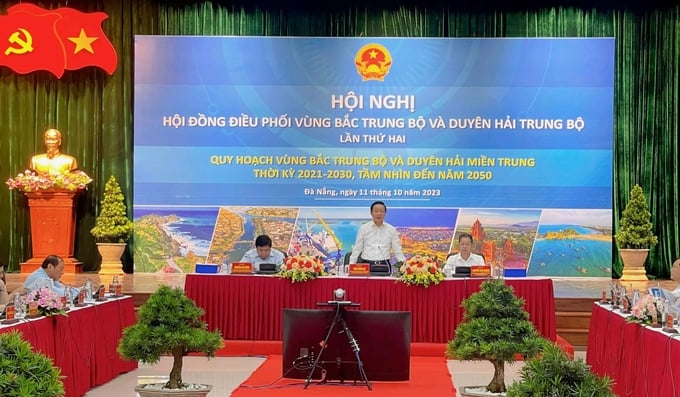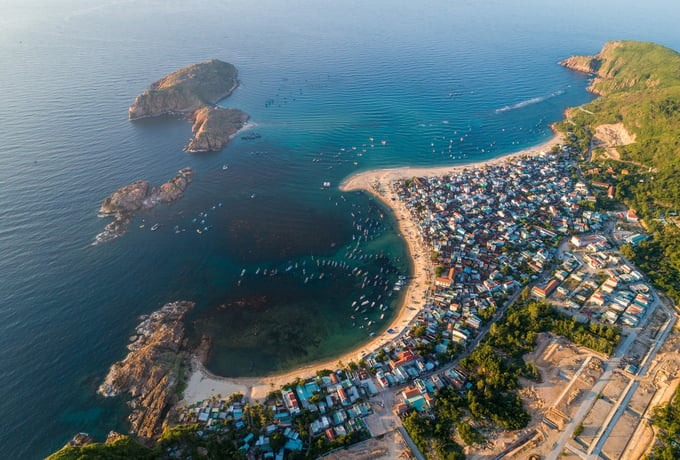November 25, 2025 | 18:39 GMT +7
November 25, 2025 | 18:39 GMT +7
Hotline: 0913.378.918
November 25, 2025 | 18:39 GMT +7
Hotline: 0913.378.918

Deputy Prime Minister Tran Hong Ha chaired the Coordination Conference for the North Central and Central Coast regions. Photo: MPI.
On October 11, Deputy Prime Minister Tran Hong Ha chaired the Coordination Conference for the North Central and Central Coast regions, with the theme "Planning for the North Central and Central Coast regions for the period 2021 - 2030, vision to 2050" in Da Nang City.
At the Conference, on behalf of the agency assigned by the Prime Minister to preside over regional planning, Minister of Planning and Investment (MPI) Nguyen Chi Dung presented the main contents of the plan.
This is a step to concretize the National Master Plan, demonstrating the major and basic orientations of national sector plans on spatial organization of development.
Planning helps pave the way, create development motivation, development potential, and new development space of the country and region and is expressed specifically on the spatial scale of each locality.
This region is identified as a particularly important strategic area in terms of politics, economics, culture, society, defence, security and foreign affairs of the whole country. This is the front of the country and the heart of the Fatherland, the gateway to the sea and the pedestal for the Central Highlands provinces.

The planning for the North Central and Central Coast regions focuses on strongly developing the marine economy combined with ensuring national defence and security at sea. Photo: VGP.
Starting from the potentials and advantages of the region, Minister of Planning and Investment Nguyen Chi Dung affirmed that the Plan offers new and groundbreaking identifications and proposals. Specifically, the planning has a vision for 2050, developing the region in accordance with the spirit of Resolution No. 26-NQ/TW of the Politburo as a region with rapid, sustainable and strong development in the marine economy.
The region has a number of large industrial, service and international cooperation centres on par with the Asian region with modern coastal economic zones, a coastal urban system that is smart, sustainable, has its own identity, and is environmentally friendly, highly resilient to natural disasters, epidemics and effective adaptation to climate change.
The planning aims to focus on investing and upgrading key infrastructure systems, especially transportation and logistics, energy, information infrastructure and digital transformation, education, training, healthcare, natural disaster prevention and control, climate change adaptation...
At the same time, focusing all resources on building transport and logistics infrastructure connecting intra-regionally and inter-regionally, focusing on maritime and railway connecting North - South, East - West, takes on the role of gateway to the sea in the Central Highlands region. Developing coastal economic space with focus and emphasis.
In particular, the Plan focuses on developing a number of driving forces and growth areas associated with major marine economic centres at regional and international levels, including 3 sub-regions: North Central sub-region (Thanh Hoa, Nghe An, Ha Tinh, Quang Binh, Quang Tri), Central Central sub-region (Thua Thien Hue, Da Nang, Quang Nam, Quang Ngai, Binh Dinh), South Central sub-region (Phu Yen, Khanh Hoa, Ninh Thuan, Binh Thuan).
The regulations' proposals aim at inter-provincial cooperation and linkage for socio-economic development such as South Thanh Hoa - North Nghe An; South Nghe An - North Ha Tinh; South Ha Tinh - North Quang Binh; Southern Phu Yen - Northern Khanh Hoa.
At the Conference, the Ministry of Planning and Investment asked for consultation and opinions from members and members of the Regional Coordination Council, relevant agencies and organizations, experts and scientists for the draft Planning for the North Central and Central Coast regions for the period 2021-2030, with a vision to 2050.
Deputy Prime Minister Tran Hong Ha emphasized that this will be the basis for all levels, sectors and localities to research, develop and implement policies, development plans, programs, and investment projects for sustainable socio-economic development of the country, the region and localities in the region.
In the recent period, the entire North Central and Central Coast regions have achieved many important results and achievements in socio-economic, security and defence matters. The average economic growth rate in the period 2005 - 2020 reached 7.3%/year, higher than the growth rate of the whole country in the same period (6.36%/year).
The economic scale of the North Central and Central Coast regions in 2020 reached VND 1,157 trillion, 3.3 times higher than in 2010. The economic structure is shifting towards service and industry as the main focus. A number of basic economic sectors, especially marine economic sectors and industries with high added value, were formed and developed; Tourism gradually became a key economic sector.
Translated by Hoang Duy

(VAN) An Giang promotes supply-demand connections, standardizes quality and builds value chains, creating a foundation for sustainable bird’s nest development and aiming to expand exports.
/2025/11/24/5339-4-nongnghiep-075331.jpg)
(VAN) Recently, the conference on 'Sustainable Fisheries Linkage Chain - Tilapia for Export' took place in Tien Hai commune, Hung Yen province.
/2025/11/21/4309-2-153400_128.jpg)
(VAN) Green and low-emission rice is paving the way for Vietnamese rice to enter high-end markets, marking the beginning of a transformation journey toward greening and elevating the national rice brand.

(VAN) ‘Right to Win’ outlines a national action plan that shapes a new vision for Viet Nam’s agriculture in an era of renewal and global integration.

(VAN) Lam Dong’s farmed sturgeon output this year is expected to reach 2,300 tons, worth VND 450 billion, affirming the brand’s position on the market.

(VAN) A surge in Ukrainian egg exports, largely driven by soaring sales to the UK over the last few years, has notably pushed up egg prices on the domestic market.

(VAN) The price of Arabica Catimor coffee in Quang Tri is currently at VND 25,000–27,000/kg (fresh cherries), the highest level ever recorded